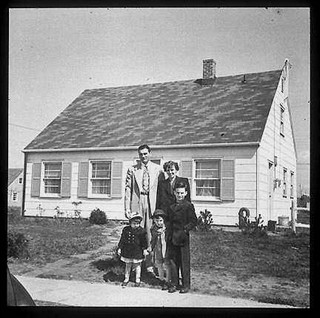 |
| Understanding the Housing Affordability Index |
If
you're not yet familiar with the NATIONAL ASSOCIATION OF REALTORS®
(NAR) housing affordability index, it is an analysis of the ability of
the average family to afford the average home with only 20% down.
Issued monthly, the index is an estimate of housing affordability based
on the median sale price of an existing single-family home, median
income, mortgage rates and assumptions concerning down payment,
property taxes, and insurance.
 Essentially,
the affordability index measures whether or not a typical family - one
defined as earning the median family income as reported by the U.S.
Bureau of the Census - can qualify for a mortgage loan on a typical
home. A typical home is defined as the national median-priced,
existing single-family home as calculated by NAR. The prevailing
mortgage interest rate is the effective rate on loans closed on
existing homes from the Federal Housing Finance Board. Essentially,
the affordability index measures whether or not a typical family - one
defined as earning the median family income as reported by the U.S.
Bureau of the Census - can qualify for a mortgage loan on a typical
home. A typical home is defined as the national median-priced,
existing single-family home as calculated by NAR. The prevailing
mortgage interest rate is the effective rate on loans closed on
existing homes from the Federal Housing Finance Board.
On the housing affordability index (HAI), a value of 100 means that a family with the median income has exactly
enough income to qualify for a mortgage on a median-priced home. A
value above 100 indicates that the family has more than enough income
to qualify for a mortgage loan on a median-priced home, with a down
payment of 20% of the home price. For example, a composite HAI of 120.0
means a family earning the median family income has 120% of the income
necessary to qualify for a conventional mortgage loan covering 80
percent of a median-priced existing single-family home. That being
said, an increase in the index shows that this same family is more than
able to afford the median priced home.
Once
again, the calculation assumes a down payment of 20% and a qualifying
ratio of 25%. This means that the monthly principal and interest
(P&I) payment cannot exceed 25% of the family's median monthly
income.
|
|
 |
As
is often stressed in the real estate industry, the first impression is
the key to selling your home. A potential buyer typically makes up
their mind ten seconds after they step in the front door. In fact,
their opinion was already taking shape as soon as they pulled into your
driveway! In a buyer's market, the power of the first impression leaves
no room for error. Staging your home for these critical moments will
dictate whether it will be sold quickly or left to collect dust on the
market.
Staging a home is not a new concept, but for many
homeowners and real estate agents, the concept of home staging is
shedding new light on how to promote a home in a shaky real estate
marketplace. Homeowners are typically left to their own devices when preparing for home showings. As a homeowner attempting to
market your product to potential buyers, it's important to use your
agent's knowledge of what buyers look for in comparable homes in your
area. Agents usually know what will help or hinder your home's
marketing potential. After all, they are experts in the field of
selling and closing.
devices when preparing for home showings. As a homeowner attempting to
market your product to potential buyers, it's important to use your
agent's knowledge of what buyers look for in comparable homes in your
area. Agents usually know what will help or hinder your home's
marketing potential. After all, they are experts in the field of
selling and closing.
It's not always easy to get a home into
selling condition in a timely manner, without some sort of experienced
assistance. Your agent will provide you with suggestions, but it's up
to you to heed their advice and implement the necessary changes. If you
don't have the time to stage your home yourself, or if you're simply
unable to envision the changes your agent suggests, consider bringing
in a professional home stager. They will work with the flow of your
home, eliminate clutter, edit the furniture layout, and help enhance
curb appeal. With the aid of a professional home stager, your house
will make a notable first impression on potential buyers.
To
sell your home right away at the price you desire, it's important to
stage your home to appeal to the "masses", or the buyers in your area.
Your agent or home stager can bring in new and fresh perspectives that
you may not have considered as a long-term occupant of the house.
Ensuring an excellent first impression means presenting your home at
its very best the first time around. By doing so, you're certain to
reap a rapid return on valuable time and money spent staging your home.
|
|
|
|
 |
Although
your yard or garden is a great place for kids and pets to enjoy, it can
also be dangerous. Common yard and garden items such as plant food,
fertilizer, and certain types of plants can be toxic to animals and
humans. Being safe, however, is easy when you know how to go about it.
Use
natural repellents. You can keep dogs and cats out of your gardens by
planting natural repellents. For instance, dogs and cats find the scent
of Coleus canina distasteful. To keep pets out, plant these annual and
lavender flowers around your gardens. Keep your children out of certain
areas in the yard or garden by teaching them where they can and can't
go and by putting up attractive borders or fencing.
Know your
toxic plants. Many beautiful plants, if ingested, can be toxic to
humans and animals. Some non-toxic plants can also cause irritation or
allergic reactions. Also, keep in mind that some plants are safe for
humans but toxic to animals. For instance, aloe, Easter lilies,
daffodils, English ivy, and tulips are all poisonous to animals. For a
list of toxic and non-toxic plants, contact your local poison control
center.

Read the labels. Not only will reading labels on lawn and garden
products inform you about how to use the product correctly, you will
also learn whether the product is toxic. If you want to be completely
safe, avoid chemicals by using organic or chemical-free products. If
you have to use toxic lawn and garden products, be sure to use child-
and pet-resistant packaging and keep the products locked up when not in
use.
Give
everyone their place. If kids and animals have areas outside that are
appealing to explore, they are less likely to go where you don't want
them. You can give your dog his own digging pit, for example. Cat
owners can plant catnip in an outdoor plot or window box. Kids should
also have their own area, filled with plenty of things to do. Swing
sets and sandboxes are always good for entertainment and exercise. You
can also set up a soccer net or basketball goal.
|
|
 |
| Increase Your Home's Energy Efficiency |
Save your money and your planet by increasing the energy efficiency of your home. Here are three ways you can do so:
1. Green up your appliances.
Appliance use comprises about 18% of a typical energy bill, with the
fridge being one of the biggest energy drains. If any of your
appliances are more than 10 years old, the EPA suggests replacing them
with energy-efficient models that bear the "Energy Star" logo. Energy
Star-rated appliances use 10%-50% less energy and water than standard
models. According to the Energy Star website, if just 1 in 10 homes
used energy-efficient appliances, it would be equivalent to planting
1.7 million new acres of trees.
2. Watch the temperature. Almost
half a home's energy consumption is due to heating and cooling. Turn
down the thermostat in cold weather and keep it higher in warm weather.
Each degree below 68°F (20°C) during colder weather saves 3%-5% more
heating energy, while keeping your thermostat at 78°F in warmer weather
will save you energy and money. A programmable thermostat will make
these temperature changes for you automatically.
Also, clean your furnace's air filter monthly during heavy usage. Depending on the age  of
your furnace, you may want to consider a new one. Today's furnaces are
about 25% more efficient than they were in the 80s. If you're in the
market for a new furnace, check out ones that have the Energy Star
label. of
your furnace, you may want to consider a new one. Today's furnaces are
about 25% more efficient than they were in the 80s. If you're in the
market for a new furnace, check out ones that have the Energy Star
label.
To keep your home cool in warmer weather, shade your east
and west windows and delay heat-generating activities, such as washing
the dishes, until evening. Whenever possible, use ceiling fans instead
of air conditioners. Light clothing in the summer is typically
comfortable between 72°F and 78°F. Moving air feels cooler, so a
slow-moving fan can easily extend that comfort range to 82°F.
3. Use energy-efficient light.
Compact Fluorescent Light bulbs (CFLs) use 66% less energy than
standard incandescent bulbs and last up to 10 times longer. Replacing a
100-watt incandescent bulb with a 32-watt CFL can save $30 in energy
costs over the life of the bulb.
|
|
 |
|
|
|
 |
|
In This Issue:
|
|
 |
|
Contact me:
|
Name

Phone
Website
|

|
|
No Better Time to Buy...
|
There
is no better time to buy a home than right now, especially if you are a
first-time home buyer. Now, the good news is that you can be a
first-time home buyer a second time! In this case, the definition of a
first-time home buyer is one who has not owned a principle residence
during the past 3 years prior to the purchase of this home. For married
taxpayers, this means that neither spouse may have owned a home in the
past 3 years. Even if you have owned a home in the past, you may
qualify to receive the $8,000 tax credit.
Remember, the tax
credit only applies until December 1, 2009. So if you are going to buy
a home this year, shop soon! You don't want to wait until the last
minute and risk losing out on the tax credit!
|

|
|
Deck, Patio, or Porch: Options for Outdoor Living
|
|
Putting
in a deck, patio, or porch can add tremendous value to your home. These
outdoor living spaces are nice features that complement the yard, and
many buyers are happy to purchase a home that already has a deck,
patio, or porch so that they don't have to take on that home
improvement project. Whether you're adding an outdoor living space for
your family's enjoyment, to add value to the home, or both, you will
find that if done right, it will be well worth the investment. If your
home and yard are conducive to such an addition, now is a good time to
start weighing your options.
|

|
|
Amazing Homes
|
|
This
awe-inspiring beach house is located on Ilhabela, an island in the
state of São Paulo, Brazil. The house was built on the cliff, facing
the sunset over the ocean. "Ilhabela" is Portuguese for "beautiful
island," but some might consider that to be an understatement. Here,
there are 35 kilometers of beaches, a coastal Atlantic rain forest, a
UNESCO Biosphere Reserve to explore, mountain peaks to climb, and over
400 majestic waterfalls cascading into the ocean. Ilhabela was
discovered in 1502, and named "São Sebastião," by Américo Vespucio, the
Italian navigator working for Portugal. The incredible scenery here
more than compensates for the home's simplicity. In fact, it is that
which surrounds the house that makes it such an amazing abode.
|
|
 |
